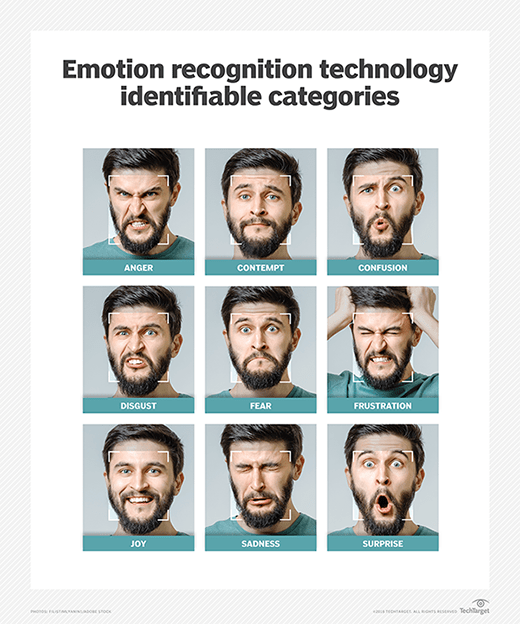emotions analytics (EA)
What is emotions analytics (EA)?
Emotions analytics (EA) software collects data on how a person communicates verbally and nonverbally to understand the person's mood or attitude. The technology, also referred to as emotional analytics, provides insights into how a customer perceives a product, the presentation of a product or their interactions with a customer service representative.
Like other data related to customer experience, emotions data is used to create strategies that improve the business's customer relationship management (CRM). EA software programs can be used with companies' data collection, data classification, data analytics and data visualization initiatives.
How emotional analytics works
EA software development requires vast amounts of labeled emotions data. The data comes from video cameras that capture facial expressions and microphones that collect data on tones of voice, for example. This data is fed into machine learning algorithms, which learn to recognize expressions, tones and other characteristics that correlate to specific emotions.
Emotions recognition technology typically categorizes emotions with the following labels:
- Anger.
- Contempt.
- Confusion.
- Disgust.
- Fear.
- Frustration.
- Joy.
- Sadness.
- Surprise.
A commonly used EA technology is text analytics, which examines word choices to determine sentiments about a product or service.

Types of emotions analytics software
With consumers posting their emotions on Snapchat, Facebook, Twitter and Instagram, as well as on websites and in videos, there is plenty of emotions data available to EA software vendors.
Emotions analytics software -- which can either be a stand-alone application or built on top of a CRM system -- uses audio mining techniques and a correlation engine to match a caller's words with human emotions.
Language-agnostic EA software can also monitor the caller's tone of voice and how often a particular word is repeated to provide more insight into the caller's emotional state. Dashboards that indicate the emotions of both the caller and the call center agent enable supervisors to know which calls go smoothly and which ones might require an intervention.
Uses of emotions analytics
Organizations have various potential uses for emotions analytics in all customer-facing departments, like improving outreach strategies and building deeper connections:
- Learn how customers are feeling. Emotions recognition software has grown in importance in call centers and in sales and marketing departments to gain insights into customer emotions. Combining sentiment analysis with existing CRM data can provide marketers and sales teams with a holistic view of customers to provide personalized ad campaigns.
- Improve marketing strategies. Emotions analytics software can also transform marketing strategies. When marketers factor in human emotions and sentiment analysis, they gain a better perspective on how to interact with the feelings of prospective customers and connect with them on a deeper level.
- Launch and evaluate test groups for new products. Emotions analytics is also used to gauge consumer reactions to new products in test groups. Negative results can help companies improve products before they make them generally available.
Resistance toward emotions analytics
The use of EA software in business is controversial, primarily because companies that employ it may not disclose the fact that they collect emotions data. In addition, critics point out that using software to analyze a person's facial expressions, body language, tone of voice or choice of words cannot provide a true picture of a customer's feelings because emotions and natural language are complex.
However, proponents of EA maintain that its insights are more valuable than information obtained through customer satisfaction surveys because EA data is created through actual customer interactions and follow-ups can be initiated in real time. With evidence that humans react emotionally first and think second, analysis and data from an emotional response may provide a truer perspective into customer sentiment.
In addition, emotions analysis technologies enable devices to collect data on users to provide personalized recommendations. This application of EA, known as affective computing or emotion AI, enables devices to analyze, process and react to people's moods and create personalized experiences.
The effect of emotions analytics
The combination of emotion-sensing technology, such as facial recognition software, with digital assistant applications is expected to significantly enhance UX.
Emotions data is valuable to businesses, as it plays a crucial role in the choice to do business with a company or not. Consumers that have a positive emotional experience with a company are more likely to recommend the company than customers with a negative experience. Customers with positive experiences are also more likely to forgive a company if it made a mistake compared to those who had a negative experience.
Emotional analysis software market
With the growth of EA and its importance in marketing, sales and service, more software vendors are investing in the emotions analytics software market. Tech giants, including Apple, Microsoft and IBM, have emotion analytics software, while smaller vendors, such as Affectiva and Eyeris Technologies, also offer facial recognition application programming interfaces and emotional analytics software.
Editor's note: This article was written by Jesse Scardina and Tim Ehrens in 2018. TechTarget editors revised it in 2023 to improve the reader experience.





